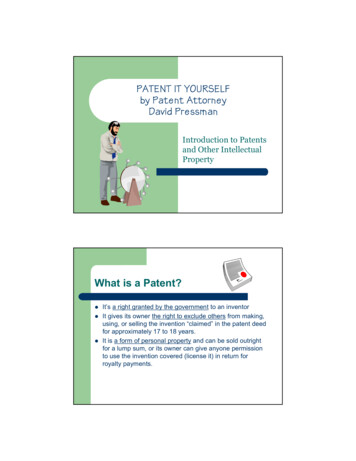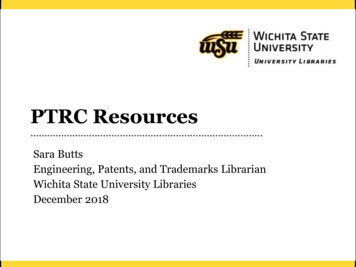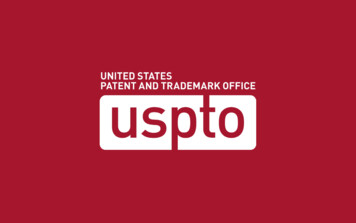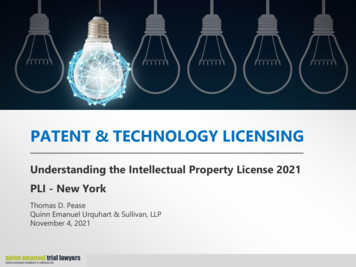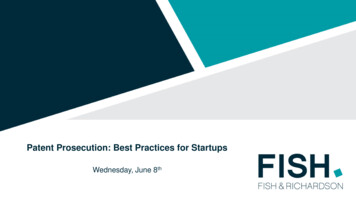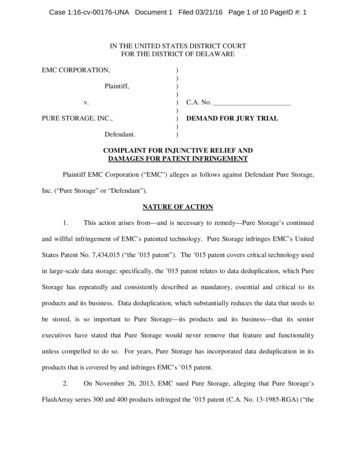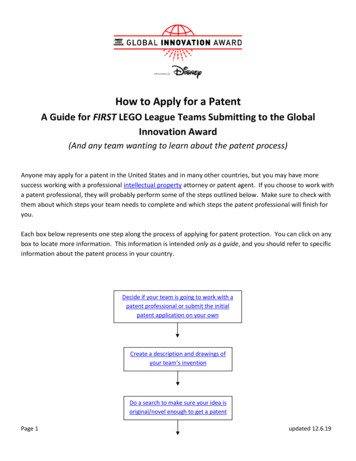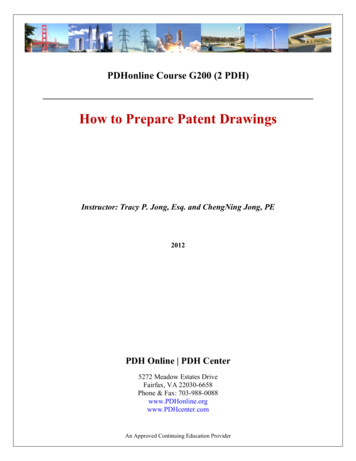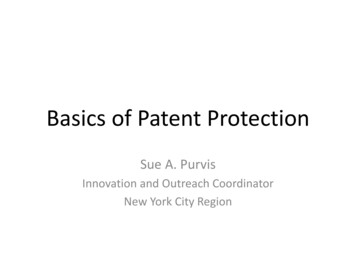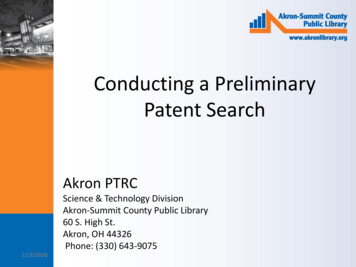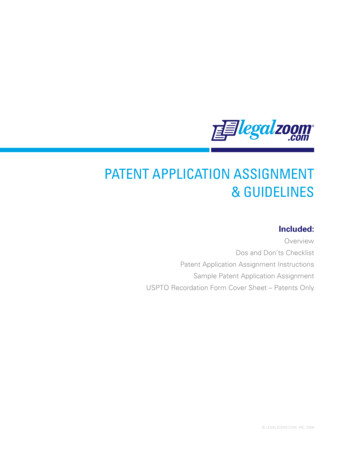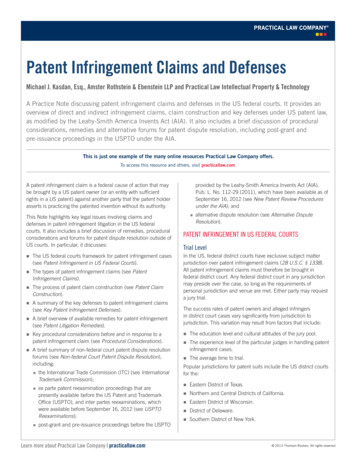
Transcription
Patent Infringement Claims and DefensesMichael J. Kasdan, Esq., Amster Rothstein & Ebenstein LLP and Practical Law Intellectual Property & TechnologyA Practice Note discussing patent infringement claims and defenses in the US federal courts. It provides anoverview of direct and indirect infringement claims, claim construction and key defenses under US patent law,as modified by the Leahy-Smith America Invents Act (AIA). It also includes a brief discussion of proceduralconsiderations, remedies and alternative forums for patent dispute resolution, including post-grant andpre-issuance proceedings in the USPTO under the AIA.This is just one example of the many online resources Practical Law Company offers.To access this resource and others, visit practicallaw.com.A patent infringement claim is a federal cause of action that maybe brought by a US patent owner (or an entity with sufficientrights in a US patent) against another party that the patent holderasserts is practicing the patented invention without its authority.This Note highlights key legal issues involving claims anddefenses in patent infringement litigation in the US federalcourts. It also includes a brief discussion of remedies, proceduralconsiderations and forums for patent dispute resolution outside ofUS courts. In particular, it discusses: TheUS federal courts framework for patent infringement cases(see Patent Infringement in US Federal Courts). Thetypes of patent infringement claims (see PatentInfringement Claims). Theprocess of patent claim construction (see Patent ClaimConstruction). Asummary of the key defenses to patent infringement claims(see Key Patent Infringement Defenses). Abrief overview of available remedies for patent infringement(see Patent Litigation Remedies). Keyprocedural considerations before and in response to apatent infringement claim (see Procedural Considerations). Abrief summary of non-federal court patent dispute resolutionforums (see Non-federal Court Patent Dispute Resolution),including: theInternational Trade Commission (ITC) (see InternationalTrademark Commission); exparte patent reexamination proceedings that arepresently available before the US Patent and TrademarkOffice (USPTO), and inter partes reexaminations, whichwere available before September 16, 2012 (see USPTOReexaminations); post-grantand pre-issuance proceedings before the USPTOLearn more about Practical Law Company practicallaw.comprovided by the Leahy-Smith America Invents Act (AIA),Pub. L. No. 112-29 (2011), which have been available as ofSeptember 16, 2012 (see New Patent Review Proceduresunder the AIA); and alternativedispute resolution (see Alternative DisputeResolution).PATENT INFRINGEMENT IN US FEDERAL COURTSTrial LevelIn the US, federal district courts have exclusive subject matterjurisdiction over patent infringement claims (28 U.S.C. § 1338).All patent infringement claims must therefore be brought infederal district court. Any federal district court in any jurisdictionmay preside over the case, so long as the requirements ofpersonal jurisdiction and venue are met. Either party may requesta jury trial.The success rates of patent owners and alleged infringersin district court cases vary significantly from jurisdiction tojurisdiction. This variation may result from factors that include: Theeducation level and cultural attitudes of the jury pool. Theexperience level of the particular judges in handling patentinfringement cases. Theaverage time to trial.Popular jurisdictions for patent suits include the US district courtsfor the: EasternDistrict of Texas. Northernand Central Districts of California. EasternDistrict of Wisconsin. Districtof Delaware. SouthernDistrict of New York. 2013 Thomson Reuters. All rights reserved.
Patent Infringement Claims and DefensesPatent Cases on AppealContributory InfringementUnlike non-patent cases, which are appealed to the appropriatecircuit court of appeals depending on the district court'sgeographic location, all appeals of patent infringement claims areheard by the US Court of Appeals for the Federal Circuit (FederalCircuit), which sits in Washington, DC.A party is liable for contributory infringement if both of thefollowing requirements are met:As with the other circuit courts of appeals, the decisions of theFederal Circuit can be appealed to the US Supreme Court (seeBox, Recent Supreme Court Patent Decisions). The Theparty sells or offers to sell within the US, or imports intothe US, a component of a patented invention or a material orapparatus for practicing a patented process.only use of the component, material or apparatus is in thepatented product or in practicing the patented process.(35 U.S.C. § 271(c).)PATENT INFRINGEMENT CLAIMSIn light of the second requirement, a key inquiry for evaluatingcontributory infringement is whether a component, material orapparatus has a "substantial non-infringing use," and thereforefalls outside the bounds of the statute.A patent infringement claim is an assertion by the patent holderthat an alleged infringer's product or process practices the patentholder's patented invention without authorization.Unlike direct infringement (see Direct Infringement), the standardfor contributory infringement imposes a knowledge requirement.The contributory infringer must have known that the component,material or apparatus was either:Types of InfringementThere are two types of infringement: Directinfringement. The accused infringer practices eachelement of the patent holder's patent claim (see DirectInfringement and All Elements Rule). Used Designed Indirectinfringement. The accused infringer does not practiceeach element of the patent holder's patent claim but either:This standard inherently requires knowledge of the patent.to direct infringement by another party (seeContributory Infringement); orA further prerequisite of contributory infringement liability is thata third party directly infringe the patent in the US (see also DirectInfringement). inducesanother party to engage in direct infringement (seeInducement).A party can only be liable for indirect infringement if another partyis a direct infringer.InducementA party who actively induces direct infringement by another partymay also be liable for infringement (35 U.S.C. § 271(b)). Likecontributory infringement, a prerequisite for inducement liability isdirect infringement by a third party.Direct InfringementA party is liable for direct infringement if, without authority, iteither:uses, offers to sell or sells a patented invention withinA patent holder claiming inducement must establish that thealleged infringer both:a patented invention into the US. Engagedthe US. Importsfor infringing use.(35 U.S.C. § 271(c).) contributes Makes,to infringe a patent.in the conduct of inducing or encouraging a thirdparty to take infringing action.(35 U.S.C. § 271(a).) Hadknowledge that the induced acts comprise patentinfringement.Direct patent infringement is a strict liability offense, meaningthat intent to infringe the patent is not needed for a finding ofdirect infringement. An alleged infringer does not have to copy apatented invention or even know about the patent to be held liablefor infringement. The alleged infringer must only have performedone of the prohibited acts listed in Section 271(a) (making,selling, using, offering to sell or importing into the US) withrespect to a product or process that is covered by the patent.(See Global-Tech Appliances, Inc. v. SEB S.A., 131 S.Ct. 2060(2011) (Global-Tech.)A patent holder must therefore demonstrate not only that thedefendant had knowledge of the patent, but that it knowinglyintended to persuade another party to take the infringing actions.This requirement is usually met by demonstrating the defendant'sactual knowledge. However, it may also be satisfied by a showingof willful blindness, where the defendant both:To be covered by the patent, however, the allegedly infringingdevice or process must include each element of a patentedclaim either literally or under the "doctrine of equivalents" (seeAll Elements Rule). If not, the alleged infringer is not liable forinfringement. 2013 Thomson Reuters. All rights reserved. Believes Takes2there is a high probability that infringement exists.deliberate actions to avoid confirming that fact.
A defendant's mere recklessness or negligence is insufficient forknowledge to be imputed under a willful blindness theory (seeGlobal-Tech, 131 S.Ct. at *26-27). Infringementof a patent claim over prior art (see also Prior ArtInvalidity).The process of resolving disputes between the parties concerningthe meaning of disputed patent claim terms is referred to as theclaim construction or Markman process.All Elements RuleTo prevail on a patent infringement claim, a patent owner mustshow by a preponderance of the evidence that each assertedpatent claim limitation is found in the accused product or process,either: Literally UnderMarkman ProcessIn Markman v. Westview Instruments, Inc., the Supreme Courtruled that the responsibility for claim construction determinationsfalls on a judge and not on a jury (517 U.S. 370 (1996)). Aftercompleting the Markman process, the judge provides instructionsto the jury on the meaning of disputed patent claim terms. Thisis similar to the manner in which the judge instructs the jury onissues of law. The jury then applies the court's claim constructionin making its factual findings on the issues of infringement andinvalidity.(see Literal Infringement).the doctrine of equivalents (see Doctrine of Equivalents).The requirement that each claim limitation be found in theaccused product or process is often called the "all elements rule."Literal InfringementLiteral infringement means that each claim limitation is literallyfound in the accused product or process.The claim construction process generally includes:For example, assume that a patent claims a chair as an apparatusfor sitting, having four legs attached to a seating member, and acurved back member attached to said seating member. In orderto literally infringe this patent, the accused chair must have both: Fourof a patent claim. Validity Eachparty's identification of the claim terms that they wouldlike the court to construe. Eachparty's proposals on claim construction. Eachparty's submission of briefing on claim construction,where it presents its arguments to the court.legs, which are attached to a seating member. Acurved back member, which is attached to the seatingmember. TheMarkman hearing.At the Markman hearing, the court may allow either party topresent expert testimony or limit the hearing to attorney argument.Following the Markman hearing, the court issues a MarkmanOrder, ruling on the construction of the disputed claim limitations.The court's construction of the disputed claim limitationsbecomes part of the jury instructions at the conclusion of the trial.Doctrine of EquivalentsUnder the doctrine of equivalents, a patent holder can proveinfringement, even if one or more asserted patent claim limitationsare not literally present in the accused product or process. Forany limitation that is not literally present, the patent holder mustshow that the differences from the literal claim requirement areinsubstantial.For an overview on claim construction and Markman hearings,see Practice Note, Patent Claim Construction: Overview (http://us.practicallaw.com/6-524-1100).A common method used to determine whether the equivalent ofa claim limitation is present in the accused product or process isthe function-way-result test. This test asks whether an element ofan accused product or process "performs substantially the samefunction in substantially the same way to obtain the same result"as an element of the patented invention (Siemens Med. SolutionsUSA, Inc. v. Saint-Gobain Ceramics & Plastics, Inc., 637 F.3d1269, 1279 (Fed. Cir. 2011)).TimingIf the district court does not have local patent rules that governwhen a Markman hearing should be held (see Local PatentRules), it can decide to hold the Markman hearing before or afterfact or expert discovery.Generally, performing claim construction before expert discoveryis more efficient for the parties. During expert discovery, theparties' experts present their positions on infringement and validityissues. If those issues depend on claim construction disputes thatare not yet resolved, the experts must outline alternative opinionsunder each party's proposed claim constructions.For example, with reference to the above chair invention, thepatent holder would have to argue infringement under thedoctrine of equivalents if the accused chair has a straight back ora back member that is not directly attached to the seat.PATENT CLAIM CONSTRUCTIONIn addition, where the accused infringer believes that simple,case-dispositive issues exist that turn on claim construction, itmay seek an early claim construction hearing. If the court agreeswith the accused infringer, an early claim construction hearingcan set the stage for the filing of summary judgment motions andlighten the burden of discovery.Claim construction plays a pivotal role in most patent infringementcases. A patent's claim language defines the scope of a patentowner's right to exclude others (see Box, Anatomy of a USPatent). Therefore, the meaning of key disputed claim limitationsmust often be ruled on to determine both:3 2013 Thomson Reuters. All rights reserved.
Patent Infringement Claims and DefensesLocal Patent Rulesevidence with caution and in the context of the intrinsic evidence.It warned that extrinsic evidence alone, particularly dictionarydefinitions, can focus "the inquiry on the abstract meaning ofwords rather than on the meaning of claim terms within thecontext of the patent." In addition, after-the-fact expert or inventortestimony is less reliable than the contemporaneous intrinsicevidence (Phillips, 415 F.3d at 1321).Certain jurisdictions that frequently hear patent infringementsuits (including the Eastern District of Texas and Northern Districtof California) have supplemented their general local rules withspecific rules for patent cases. These local patent rules generallyspecify the timing of the key events in the patent litigationprocess, including the claim construction procedure.Generally, local patent rules also require at a relatively early stagein the litigation that:Evaluating Claim TerminologyThe words of a claim are generally given their ordinary andcustomary meaning. This is the meaning that the terms wouldhave to "a person of ordinary skill in the art in question at the timeof invention" (Phillips, 415 F.3d at 1312-13). Thepatent holder specifies its "infringement contentions,"which are written explanations identifying the accused productor products, or process or processes it asserts infringe itspatent claims and why.The following factors can also provide insights into the intendedmeaning of a term: Thealleged infringer specify its "invalidity contentions,"which are written explanations outlining the prior art it claimsinvalidate the asserted patent claims and why.Disclosure of the infringement and invalidity contentions helps tocrystallize the disputed claim terms for claim construction.The public materials that comprise the patent's "intrinsic record"provide the most important evidence for construing a claim. Theseconsist of:patent's specification (see Box, Anatomy of a US Patent).Disclaimer RuleUnder the "disclaimer" rule, any claim interpretation that wasdisclaimed when the patent was prosecuted should be excludedfrom the claim construction process (see Vitronics, 90 F.3d at1583). Theprosecution history (the record of communication betweenthe patent applicant and the USPTO during the patentapplication process).During prosecution, the patent applicant may need to explain ornarrow the scope of the claimed invention in response to priorart that is cited by the patent examiner and used to reject thepending claims. Where the patent applicant narrowed its claimsor disclaimed a certain interpretation in order to get the claimsallowed, it is unfair to later allow a broader interpretation inlitigation.(See Phillips, 415 F.3d at 1317.)The policy rationale for primary reliance on the intrinsic recordstems from its public notice function. In theory, a third partyreviewing the intrinsic record should be able to determine whetherit infringes the patent or not. In addition, the contemporaneousintrinsic record generally is considered more reliable than othertypes of evidence, including after-the-fact testimony of paidexperts.KEY PATENT INFRINGEMENT DEFENSESAn alleged infringer can assert a number of common defenses inresponse to a patent infringement claim, including:Although intrinsic evidence is given significant weight, courts canalso evaluate extrinsic evidence, including: Expert Adefenses based on prior art (see Prior Art Invalidity).These include: Dictionaries. anticipationtreatises. obviousness(See Phillips, 415 F.3d at 1317.) Invalidity(see Anticipation Defense); and(see Obviousness Defense).defenses based on the patent holder's failure to meetstatutory requirements (see Non-prior Art Invalidity).In Phillips, the Federal Circuit advised courts to consider extrinsic 2013 Thomson Reuters. All rights reserved.defense of non-infringement (see Non-infringement). Invaliditytestimony. Learneddifferences among a patent's claims.However, the claim terms should also be understood in thecontext of the specification, because "the best source forunderstanding a technical term is the specification from which itarose, informed, as needed, by the prosecution history" (Phillips,415 F.3d at 1315). The inventor can also expressly defineterms in the specification. In these cases, the inventor's expressdefinition governs.Intrinsic versus Extrinsic Evidence The Theuse of the same terms in different claims of the samepatent on the theory that terms within a patent are typicallyused in a consistent manner.The proper methodology for claim construction is set out inVitronics and more recently in Phillips (see Vitronics Corp. v.Conceptronic, Inc., 90 F.3d 1576 (Fed. Cir. 1996) and Phillips v.AWH Corp., 415 F.3d 1303 (Fed. Cir. 2005) (en banc)).claims themselves.term's context within a claim. TheMethodology The The4
March 16, 2013 (see AIA § 3 (2011) and Leahy-Smith AmericaInvents Act: Overview: First-inventor-to-file Patent System (http://us.practicallaw.com/6-508-1601)). It is therefore now necessaryto distinguish: Theequitable defense of inequitable conduct arising from thepatent holder's conduct during the prosecution process (seeInequitable Conduct).Defenses based on the patent holder's express or impliedauthorization to use the patent (see Licenses and PatentExhaustion). Priorart for patents and patent applications having an effectivefiling date before March 16, 2013 (pre-AIA prior art). Priorart for patents and patent applications having an effectivefiling date on or after March 16, 2013 (AIA prior art).General equitable defenses that bar the patent holder frommaking a claim (see Laches and Equitable Estoppel).For both pre-AIA and AIA-prior art, Section 102 of the PatentAct specifies the categories of prior art that can be used todemonstrate invalidity. Prior art includes any disclosure meetingSection 102's requirements.Non-infringementThe most common defense to a patent infringement claim is thatthe accused product or process does not include or perform oneor more of the required claim limitations and therefore does notinfringe the asserted patent claim. That is, the accused product orprocess is not the same as the patented invention.Pre-AIA prior art is generally defined with reference to the patentholder's date of invention, rather than the patent's applicationfiling date. The date of invention can depend on the date of theinventor's conception and whether the inventor was diligent inreducing the invention to practice, either by itself or another entitymaking a working prototype or filing a patent application. Thereare four main categories of pre-AIA prior art:One special sub-category of the non-infringement defense isa claim of divided or joint infringement. Where the accusedinfringement occurs through multiple entities' use of a claimedsystem or method (rather than a single entity), a theory of dividedinfringement (also called joint infringement) can support a noninfringement defense (see Box, Divided or Joint Infringement). Section102(a) prior art references are disclosures occurringbefore the patent holder's date of invention. The patent holdercan overcome Section 102(a) prior art by "swearing behind" it.This is proving that the patented invention was invented beforethe date of the prior art reference. These disclosures can be:Prior Art InvalidityAnother common defense to patent infringement is showing thatthe asserted patent claim is invalid. USor foreign patents or printed publications that describethe invention; orBecause a patent is granted only after the USPTO examines it,each issued patent claim is presumed to be valid (35 U.S.C. §282). A party seeking to invalidate a patent claim must thereforeprove invalidity by clear and convincing evidence (see MicrosoftCorp. v. i4i Ltd. P'ship, 131 S.Ct. 2238 (2011) (Microsoft)). This isa higher evidentiary standard than the preponderance of evidencestandard required to prove infringement. evidencethat the invention was known or used by others inthe US.(35 U.S.C § 102(a) (2011).) Section102(b) prior art references are disclosures occurringmore than one year before the US patent filing date (the"critical date" or "statutory bar date"). This category of pre-AIAPrior Art is alone in being defined by the patent applicationfiling date, not the date of invention, and cannot be swornbehind. These disclosures can be:When relying on prior art (see Prior Art), an invalidity defense cantake the form of either: Ananticipation defense, asserting that the claim is not novel(someone else came up with the exact claimed invention first)(see Anticipation Defense). USor foreign patents or printed publications that describethe invention; or products Anobviousness defense, asserting that the claim is obvious(a person of skill in the art at the time of filing of the patentapplication would have considered the claimed invention tobe obvious based on the state of the art at that time) (seeObviousness Defense).that were in public use or on sale in the US.(35 U.S.C § 102(b) (2011).) Section102(e) prior art references are disclosures thatwere filed before the patent holder's date of invention, evenif they are not published until after the date of invention. LikeSection 102(a) prior art references, the patent holder canovercome Section 102(e) prior art by swearing behind it. Thesedisclosures can be:Prior ArtAnticipation and obviousness defenses rely on prior art, which aredisclosures made to the public either before the invention date orbefore the patent filing date. patentsand patent applications filed by a third party in theUS before the date of the patent holder's inventions; andThe AIA, enacted on September 16, 2011, transitioned theUS from a "first-to-invent" to a "first-inventor-to-file" patentsystem. It includes changes to the definition of prior art forpatent applications having an effective filing date on or after patentapplications filed under the Patent Cooperation Treaty(PCT) that designate the US and are published in English.(35 U.S.C § 102(e) (2011).)5 2013 Thomson Reuters. All rights reserved.
Patent Infringement Claims and Defenses Section102(g)(2) prior art references are inventions of a thirdparty before the patent holders' date of invention that were not"abandoned, suppressed, or concealed" (35 U.S.C § 102(g)(2)(2011)). For example, where a prior art invention is ultimatelycommercialized in a product, this may evidence that the priorinvention was not abandoned, suppressed, or concealed. LikeSection 102(g)(2) prior art references, the patent holder canovercome Section 102(g)(2) prior art by swearing behind it.The "strict identity" test for anticipation mirrors the all elementstest for infringement (see All Elements Rule). However, insteadof comparing each element of the patent claim to an accusedproduct, each element of the patent claim is compared to thedisclosure of a single prior art reference. For a patent claim to beinvalid as anticipated, that prior art reference must disclose eachelement, either explicitly or inherently, as arranged in the claim.An inherent disclosure occurs where the element is not expresslydisclosed but the practice of the prior art reference wouldinevitably include the element.AIA prior art is defined with reference to the effective filing dateof the relevant patent application. It may include any publicdisclosure if it occurs before the effective filing date of the relevantpatent application. This may include: Patentsarticles.brochures and specifications. Instruction ActualAn accused infringer may also assert an obviousness defense,generally by presenting a combination of prior art references.Obviousness means that in view of the prior art references,the claimed invention would have been obvious to a person ofordinary skill in the art.and published patent applications. Scientific ProductObviousness Defensemanuals.The inquiry on whether a patent claim is obvious involvesdetermining:products (public demonstrations, offers for sale orsales). Textbooks. The(See 35 U.S.C. § 102(a), AIA § 3 (2011) and Leahy-SmithAmerica Invents Act: Overview: Scope of Prior Art (http://us.practicallaw.com/6-508-1601)). Thedifference between what is taught by the prior art and theclaimed invention. Whetherthat patent claim would have been obvious to one ofordinary skill in the art at the time of the invention.However, the AIA excludes from the definition of prior art:(Graham v. John Deere Co., 383 U.S. 1, 17 18 (1966).) Disclosuresmade one year or less before the effective filingdate of the relevant patent application and that are madeeither:Generally "[t]he combination of familiar elements according toknown methods is likely to be obvious when it does no more thanyield predictable results" (see KSR Int'l Co. v. Teleflex, Inc., 550U.S. 398, 416 (2007) (KSR)). bythe inventor or someone who obtained the disclosedsubject matter from the inventor; or aftera public disclosure by the inventor or someone whoobtained the disclosed subject matter from the inventor.Non-prior Art InvalidityAn alleged infringer may also assert that a patent is invalid basedon the patent's failure to meet certain statutory requirements. Likeany invalidity defense, invalidity on these grounds requires proofby clear and convincing evidence. Certaindisclosures in earlier patents or published patentapplications where the subject matter of the disclosure: contains wassubject matter obtained from the inventor;previously disclosed by the inventor; or wasowned by the same person or under an obligationof assignment to the same person as the relevant patentapplication.Compliance with Specification RequirementsMost non-prior art invalidity defenses are based on the patentspecification's failure to meet certain requirements of Section 112of the Patent Act (35 U.S.C. § 112). These requirements include:(See 35 U.S.C. § 102(b), AIA § 3 (2011) and Leahy-SmithAmerica Invents Act: Overview: Statutory Exceptions to Prior Art(http://us.practicallaw.com/6-508-1601).) Thewritten description requirement. The specification mustinclude a complete written description of the claimed invention.Consistent with its goal of moving the US to a "first-inventor-to-file"patent system, the AIA eliminates prior invention as a category ofprior art (see 35 U.S.C. § 102(a), AIA § 3 (2011) and Leahy-SmithAmerica Invents Act: Overview: Categories of Prior Art (http://us.practicallaw.com/6-508-1601).) Theenablement requirement. The specification must includesufficient specificity and detail so that after reading thespecification a person of ordinary skill in the relevant art canpractice the invention without undue experimentation.Anticipation DefenseAnticipation refers to the defense that a patent is invalid becauseit is not novel. This means that the exact claimed invention wasinvented earlier by another. 2013 Thomson Reuters. All rights reserved.scope and content of the prior art.6
Inequitable Conduct Thebest mode requirement. The specification must set outthe best way known to the inventor of practicing the invention.This defense may only be raised in proceedings filed beforeSeptember 16, 2011. In all other proceedings, a failure todisclose the best mode is not a basis on which a patent claimcan be held invalid (see 35 U.S.C. § 282, AIA § 15 (2011)and Leahy-Smith America Invents Act: Overview: Best ModeRequirement le conduct is an equitable defense (a defense notbased in the Patent Act) where the alleged infringer claims that aparty associated with obtaining the asserted patent breached itsduties of disclosure or candor to the USPTO when the patent wasprosecuted. Because the patent application process is an ex parteprocess, applicants and their counsel must:Section 112 also requires that the inventor distinctly claimthe invention in the patent claims. If a claim is ambiguous orindeterminate, then the claim may be found to be invalid. CiteExcept as set out above with respect to the best moderequirement, the failure to meet any Section 112 requirementcan provide a basis for invalidity (see, for example, Ariad Pharm.,Inc. v. Eli Lilly and Co., 598 F.3d 1336, 1341 (Fed. Cir. 2010) (enbanc)).A successful inequitable conduct defense can render all of apatent's claims unenforceable and therefore provide a completedefense to infringement.truthfully and with candor in making arguments or takingpositions during prosecution.A claim for inequitable conduct is in the nature of fraud andt
a back member that is not directly attached to the seat. PATENT CLAIM CONSTRUCTION Claim construction plays a pivotal role in most patent infringement cases. A patent's claim language defines the scope of a patent owner's right to exclude others (see Box, Anatomy of a US Patent). Therefore, the meaning of key disputed claim limitations
